Hello guys
We're struggling a bit with representing applications performing tasks in a BPMN diagram.
Here is what we tried so far.
1) Use a service task, add the application performing the task as a task attribute. Downsides: you can't reuse existing application type elements when filling in the attribute (can you ? ).
2) Use a lane to represent the application. Downsides: you can't reuse existing application type elements for the lane (except if you use the Aris e-bpmn diagram). Moreover, if there are tasks performed by an actor, some with the application, others manually, in which lanes do you put these different tasks?
3) Use a data store to represent the application: the trouble is, a data store is mapped to an Information Carrier, an not an application type, in Aris.
4) Use a separate process to represent the application.
Thanks for your inputs !
Regards
MB




M. Zschuckelt on
Hello Michel,
the answer is simple: Don't do it. BPMN is a process notation. Application architecture is out of scope. Please refer to chapter 7.2 of the BPMN specification.
You wouldn't use a screw driver to drive a nail into the wall. You can try, but you will probably hurt yourself. Use BPMN for what it was made for: Description of process logic.
I can see 2 options for you:
1. Do an assignment of a "Task allocation diagram" to each BPMN task. Assign your IT systems to each step in those.
2. Use EPC notation instead. It can accommodate all the interesting business resources at a glance that you apparently want to meet at the activities. That is what this notation was invented and made for. There are variants of this notation that make it feel a bit like BPMN, e. g. table layout, horizontal layout.